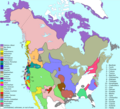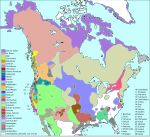File:Langs N.Amer.png

Original file (1,290 × 1,170 pixels, file size: 599 KB, MIME type: image/png)
Captions
Captions
Contents
Summary
[edit]
|
File:Langs N.Amer.svg is a vector version of this file. It should be used in place of this PNG file when not inferior.
File:Langs N.Amer.png → File:Langs N.Amer.svg
For more information, see Help:SVG.
|
|
Distribution of North American language families north of Mexico
- Deutsch (German): Image:Langs_N.Amer_Deutsch.png
- español (Spanish): Image:Langs N.Amer espanol.png
- français (French): Image:Langs N.Amer fr.png
Info
[edit]- created by en:User:ish ishwar in 2005, using the GIMP software
- released under CC-by-2.0
About sources
[edit]Map redrawn and modified primary based on two maps by cartographer Roberta Bloom appearing in Mithun (1999:xviii–xxi). Incidentally, these maps are very derivative of the Driver map of the 1950s–60s (which means that, although published in 1999, it is not as up-to-date as one might think). The other main source used is the up-to-date and very well-done map found in Goddard (1996), which was revised as Goddard (1999). Essentially, Bloom's map was used for the projection and general outline of language borders while Goddard's maps were used to adjust Bloom's borders to reflect the more recent research.
Additional references include Sturtevant (since 1978), Mithun (1999:606–16), and Campbell (1997:353–76). Mithun and Campbell have several maps based on the maps found in Sturtevant (since 1978) and Bright (1992).
Mithun, M. (2001) The Languages of Native North America, Cambridge Language Surveys, Cambridge University Press ISBN: 978-0-521-29875-9.
About map content
[edit]- Map delineates each language family in a unique color.
- Language isolates are all in dark grey, e.g. Chitimacha (#7) is an isolate in Louisiana. This is not meant to imply any relationship among them whatsoever. All isolates are assigned a number and listed on the right side of map.
- Unclassified languages (i.e. #1 Beothuk, #4 Calusa, #8 Adai, #10 Karankawa, #12 Aranama, #15 Solano, #19 Esselen, #26 Cayuse) are in light grey and are also assigned a number and listed with the isolates on the right. (Unclassified languages in the case of North America are unclassified because there is not sufficient data to determine genealogical relationship.)
- Areas in white are either
- uninhabited (in Alaska, Canada, Greenland),
- unknown (due to early extinction and little or no data; this is mostly in the East), or
- outside of subject area (in Mexico). (note that Seri (#17) is included because it is usually considered part of the Southwest culture area and also included in various Hokan phylum proposals.)
- This is a historical map: Although most languages are still spoken in North America, the extent of their distribution has been profoundly affected by European contact — many languages have become extinct (sometimes including even the peoples). (See Endangered language.)
- Language areas are those at earliest time of European contact, as far as can be determined. Since contact occurred at different times in different areas, no historical Native American maps of the entire continent are of a single time period.
- Language areas are not as well-defined as this map would suggest: borders are often fuzzy and arbitrary and the entire language area may not be fully occupied by language speakers.
- Na-Dene here is Athabaskan-Eyak-Tlingit, excluding Haida (#28).
- The following groupings are disputed by some (or are considered not fully demonstrated):
- Plateau Penutian (aka Shahapwailutan) = Klamath-Modoc (isolate) + Molala (isolate) + Sahaptian (family). Sometimes Cayuse (#26) is included in Plateau Penutian, but this language is not very well documented and is now extinct. Thus, it is considered unclassified here.
- Yuki-Wappo = Yuki (isolate) + Wappo (isolate).
To do
[edit]- translation into Spanish & other languages
- extend Mexico coverage (for Comecrudo)?
Links
[edit]You might want to compare this map with these two older (1967) maps of only the USA:
There is also an Inuktitut dialect map in Wikipedia:
Be sure to check out the beautiful work of Mutur Zikin (www.muturzikin.com):
- Distribution Linguistique Aux Étas-Unis Et Canada (in English, Basque, French, Spanish)
- Distribution Linguistique En Amérique Latine (in English, Basque, French, Spanish)
Looking for more maps of South America? Go here:
A (older) map of Mexico (provided by the University of Texas):
- Map itself: www.lib.utexas.edu/../aboriginal_map.jpg (in English)
- Text accompanying map: www.lib.utexas.edu/../aboriginal_languages_txt.jpg (in English)
Some pages in Wikipedia:
- Classification schemes for indigenous languages of the Americas (in English)
- Indigenous languages of the Americas (in English)
- Mesoamerican languages (in English)
- Languages of Peru (in English)
- Category: Indigenous languages of the Americas (in English)
- Indigene amerikanische Sprachen (in German)
- Lenguas amerindias (in Spanish)
- Langues amérindiennes (in French)
Some other sites on American languages (in English):
- The Society for the Study of the Indigenous Languages of the Americas
- The Archive of the Indigenous Languages of Latin America archive copy at the Wayback Machine
- Native Languages of the Americas
You might also be interesting in:
- the Aboriginal Mapping Network (in English)
Other maps in this series
[edit]These other maps of single families are generated from the main map above.
- Adai
- Algic - Algisch - algiques
- Alsean - Alsea - alséannes
- Atakapa
- Beothuk - béothuk
- Cayuse
- Chimakuan
- Chimariko
- Chinookan - Chinook
- Chitimacha
- Chumashan - Chumash
- Coahuilteco
- Cotoname
- Eskimo-Aleut - Eskimo-Aleutisch - eskimo-aléoutes
- Esselen
- Haida
- Karankawa
- Karuk - Karok
- Keresan - Keres
- Kiowa-Tanoan
- Kutenai
- Muskogean - Muskogee
- Na-Dene - na-déné
- Natchez
- Salishan - Salish
- Utian - Uti
- Yokutsan - Yokut - yokuts
Bibliography
[edit]- Bright, William (Ed.). (1992). International encyclopedia of linguistics (Vols. 1-4). New York: Oxford University Press.
- Campbell, Lyle. (1997). American Indian languages: The historical linguistics of Native America. New York: Oxford University Press. ISBN 0-19-509427-1.
- Driver, Harold E. (1969). Indians of North America (2nd rev. ed.). Chicago: Chicago University Press. (Original work 1961).
- Goddard, Ives. (1996). Native languages and language families of North America [Map]. In I. Goddard (Ed.), Handbook of North American Indians: Languages (Vol. 17). (W. C. Sturtevant, General Ed.) Washington, D. C.: Smithsonian Institution. ISBN 0-1604-8774-9.
- Goddard, Ives. (1999). Native languages and language families of North America (rev. and enlarged ed. with additions and corrections). [Map]. Lincoln, NE: University of Nebraska Press (Smithsonian Institute). (Updated version of the map in Goddard 1996). ISBN 0-8032-9271-6.
- Krauss, Michael. (1982). Native peoples and languages of Alaska (rev. ed.). [Map]. Fairbanks, AK: Alaska Native Language Center. ISBN 0-933769-00-8.
- Mithun, Marianne. (1999). The languages of Native North America. Cambridge: Cambridge University Press. ISBN 0-521-23228-7 (hbk); ISBN 0-521-29875-X.
- Powell, John W. (1891). Indian linguistic families of America north of Mexico. Seventh annual report, Bureau of American Ethnology (pp. 1-142). Washington, D.C.: Government Printing Office. (Reprinted in P. Holder (Ed.), 1966, Introduction to Handbook of American Indian languages by Franz Boas and Indian linguistic families of America, north of Mexico, by J. W. Powell, Lincoln: University of Nebraska).
- Sebeok, Thomas Albert (Ed.). (1973). Current trends in linguistics: Linguistics in North America (Vol. 10, Pts. 1-2). The Hague: Mouton.
- Sturtevant, William C. (Ed.). (1978-present). Handbook of North American Indians (Vols. 1-20). Washington, D. C.: Smithsonian Institution. (Vols. 1-3, 16, 18-20 not yet published).
Thank You
[edit]Thanks goes to:
- User:Mark Dingemanse for creating his lingustic maps of Africa which inspired me to create this one
- en:User:Wapcaplet for helpful suggestions concerning form
- User:Vlad2i for kindly providing the Français translation
- de:Benutzer:Napa for kindly providing the Deutsch translation
- en:User:kwamikagami for helpful suggestions concerning classification, content, and form
- en:User:Deglr6328 for helpful suggestions concerning accessibility issues involving viewers with color blindness
Licensing
[edit]- You are free:
- to share – to copy, distribute and transmit the work
- to remix – to adapt the work
- Under the following conditions:
- attribution – You must give appropriate credit, provide a link to the license, and indicate if changes were made. You may do so in any reasonable manner, but not in any way that suggests the licensor endorses you or your use.
File history
Click on a date/time to view the file as it appeared at that time.
| Date/Time | Thumbnail | Dimensions | User | Comment | |
|---|---|---|---|---|---|
| 08:12, 18 August 2005 |  | 1,449 × 1,315 (828 KB) | Ish ishwar (talk | contribs) | water border, adjustments | |
| 21:22, 17 August 2005 |  | 1,449 × 1,315 (838 KB) | Ish ishwar (talk | contribs) | country border, adjust utian, yokutsan, wintuan, yukian, pomoan | |
| 08:03, 17 August 2005 |  | 1,449 × 1,315 (823 KB) | Ish ishwar (talk | contribs) | adjustments | |
| 23:32, 16 August 2005 |  | 1,464 × 1,328 (601 KB) | Ish ishwar (talk | contribs) | adjust Yuchi, Timucua, Calusa, Muskogean, Iroquioan | |
| 22:09, 16 August 2005 |  | 1,464 × 1,328 (601 KB) | Ish ishwar (talk | contribs) | + isolate, correct families | |
| 19:13, 16 August 2005 |  | 1,464 × 1,328 (542 KB) | Ish ishwar (talk | contribs) | darken patterns | |
| 18:16, 16 August 2005 |  | 1,464 × 1,328 (544 KB) | Ish ishwar (talk | contribs) | ||
| 01:57, 26 May 2005 |  | 1,008 × 914 (436 KB) | Ish ishwar (talk | contribs) | biloxi is siouan-catawba not isolate, adjust siouan, adjust color | |
| 06:41, 23 May 2005 |  | 1,005 × 912 (423 KB) | Ish ishwar (talk | contribs) | add families, add Chimakuan, correct wakashan, salishan, takelma, kalapuyan, change color | |
| 17:00, 18 May 2005 |  | 873 × 792 (306 KB) | Ish ishwar (talk | contribs) | distribution of North American language families and language isolates |
You cannot overwrite this file.
File usage on Commons
The following 8 pages use this file:
File usage on other wikis
The following other wikis use this file:
- Usage on af.wikipedia.org
- Usage on an.wikipedia.org
- Usage on ar.wikipedia.org
- Usage on azb.wikipedia.org
- Usage on az.wikipedia.org
- Usage on bat-smg.wikipedia.org
- Usage on be-tarask.wikipedia.org
- Usage on beta.wikiversity.org
- Usage on be.wikipedia.org
- Usage on bg.wikipedia.org
- Usage on br.wikipedia.org
- Usage on ca.wikipedia.org
- Usage on ca.wikimedia.org
- Usage on cs.wikipedia.org
- Usage on cv.wikipedia.org
- Usage on da.wikipedia.org
- Usage on da.wikibooks.org
- Usage on de.wikipedia.org
- Usage on dsb.wikipedia.org
- Usage on en.wikipedia.org
- History of the Americas
- North America
- Native Americans in the United States
- First Nations in Canada
- Linguistics and the Book of Mormon
- Lower Rio Grande Valley
- User:Ish ishwar
- Classification of the Indigenous languages of the Americas
- Wikipedia:Featured pictures thumbs/03
- Indigenous peoples of the Americas
- Wikipedia:Wikipedia Signpost/2005-12-26/Features and admins
- Wikipedia:Featured picture candidates/December-2005
- Wikipedia:Featured picture candidates/Indigenous language families north of Mexico
- User:Cyde/Featured pictures
- Talk:New World
- Wikipedia:Picture of the day/April 2006
- Wikipedia:POTD/April 1, 2006
- Wikipedia:Picture of the day/April 1, 2006
- Wikipedia:Today's second feature/April 1, 2006
- Portal:North America/Selected picture
- User talk:Wapcaplet/Archive 3
- Wikipedia:POTD column/April 1, 2006
- Wikipedia:POTD row/April 1, 2006
View more global usage of this file.
Metadata
This file contains additional information such as Exif metadata which may have been added by the digital camera, scanner, or software program used to create or digitize it. If the file has been modified from its original state, some details such as the timestamp may not fully reflect those of the original file. The timestamp is only as accurate as the clock in the camera, and it may be completely wrong.
| PNG file comment |
|
|---|---|
| File change date and time | 00:39, 11 November 2006 |
| Horizontal resolution | 78.74 dpc |
| Vertical resolution | 78.74 dpc |
